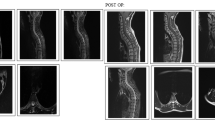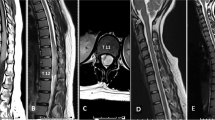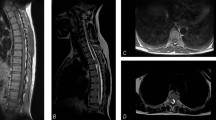Abstract
Sirenomelia, also known as the mermaid syndrome, is a rare congenital malformation of uncertain etiology. It is characterized by fusion of the lower limbs and commonly associated with severe urogenital and gastrointestinal malformations. In this report, we describe the first case of an infant with sirenomelia and a massive angiomatous lumbosacral myelocystocele.
This is a preview of subscription content, access via your institution
Access options
Subscribe to this journal
Receive 12 print issues and online access
$259.00 per year
only $21.58 per issue
Buy this article
- Purchase on Springer Link
- Instant access to full article PDF
Prices may be subject to local taxes which are calculated during checkout



Similar content being viewed by others
References
Stocker JT, Heifetz SA, Sirenomelia . A morphological study of 33 cases and review of the literature. Perspect Pediatr Pathol 1987;10:7–50.
Duhamel B . From the mermaid to anal imperforation: the syndrome of caudal regression. Arch Dis Child 1961;36:153–5.
Stevenson RE, Lyons Jones K, Phelan MC, et al. Vascular steal: the pathogenetic mechanism producing sirenomelia and associated defects of the viscera and soft tissues. Pediatre 1986;78(3):451–7.
Kallen B, Castilla EE, Lancaster PA, et al. The cyclops and the mermaid: an epidemiological study of two types of rare malformation. J Med Genet 1992;29:30–5.
Schiesser M, Holzgreve W, Lapaire O, et al. Sirenomelia, the mermaid syndrome — detection in the first trimester. Prenat Diagn 2003;23:493–5.
Stanton MP, Penington EC, Hutson JM . A surviving infant with sirenomelia (mermaid syndrome) associated with absent bladder. J Pediatr Surg 2003;38(8):1266–8.
Murphy JJ, Fraser GC, Blair GK . Sirenomelia: case of the surviving mermaid. J Pediatr Surg 1992;27(10):1265–68.
Goodlow OG, McCoy Sibley RI, Allen BG, et al. Sirenomelia: mermaid syndrome. J Natl Med Assoc 1988;80(3):343–46.
Mclone DG, Naidich TP . Terminal myelocystocele. Neurosurgery 1985;16(1):36–43.
Zaw W, Stone DG . Caudal regression syndrome in twin pregnancy with type II diabetes. J Perinatol 2002;22:171–4.
Valenzano M, Paoletti R, Rossi A, et al. Sirenomelia. Pathological features, antenatal ultrasonographic clues, and review of current embryogenic theories. Hum Reprod Update 1999;5(1) :82–6.
Author information
Authors and Affiliations
Rights and permissions
About this article
Cite this article
Browne, M., Fitchev, P., Adley, B. et al. Sirenomelia with an Angiomatous Lumbosacral Myelocystocele in a Full-term Infant. J Perinatol 24, 329–331 (2004). https://doi.org/10.1038/sj.jp.7211085
Published:
Issue Date:
DOI: https://doi.org/10.1038/sj.jp.7211085
This article is cited by
-
Sirenomelia in a Nigerian triplet: a case report
Journal of Medical Case Reports (2011)



